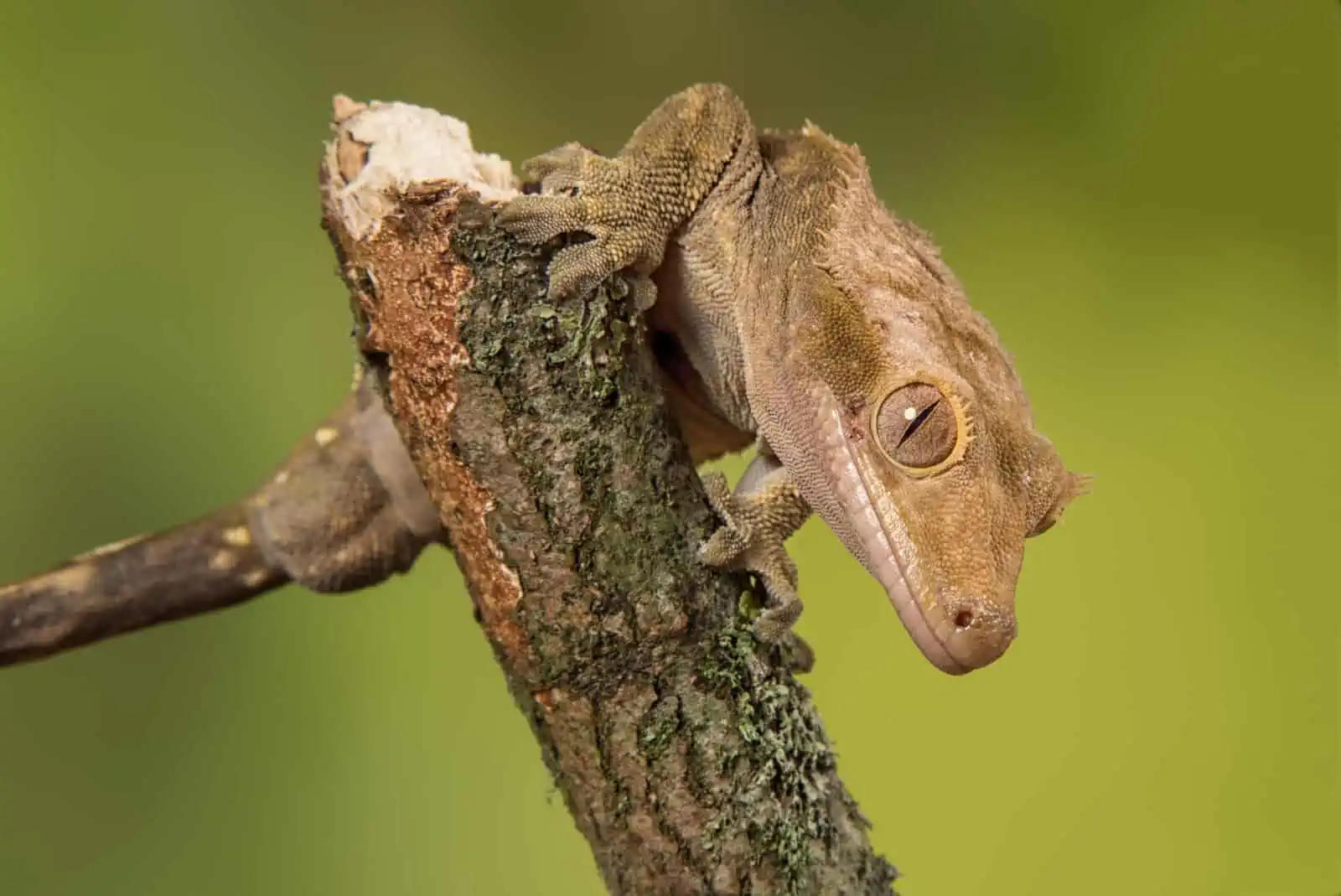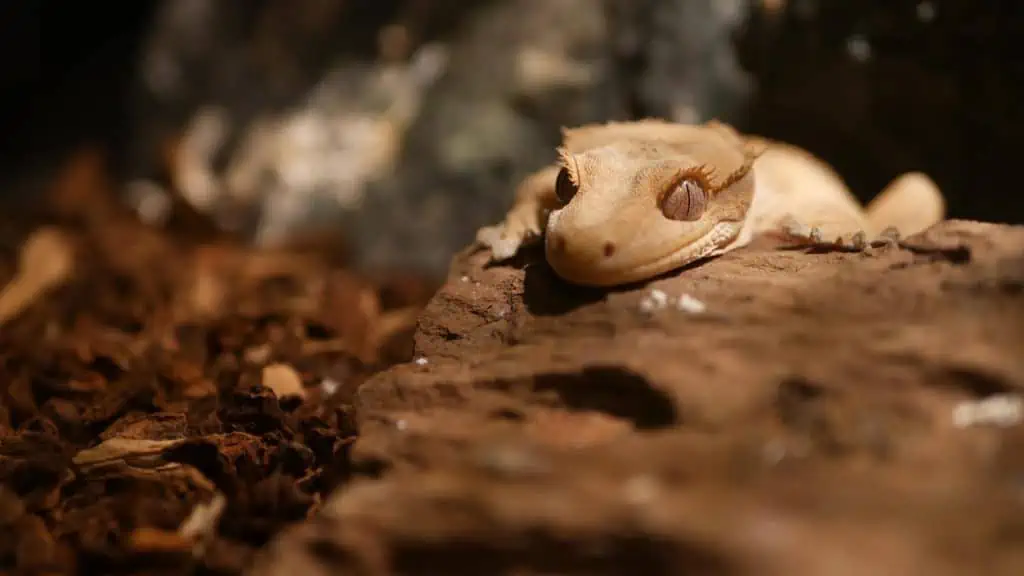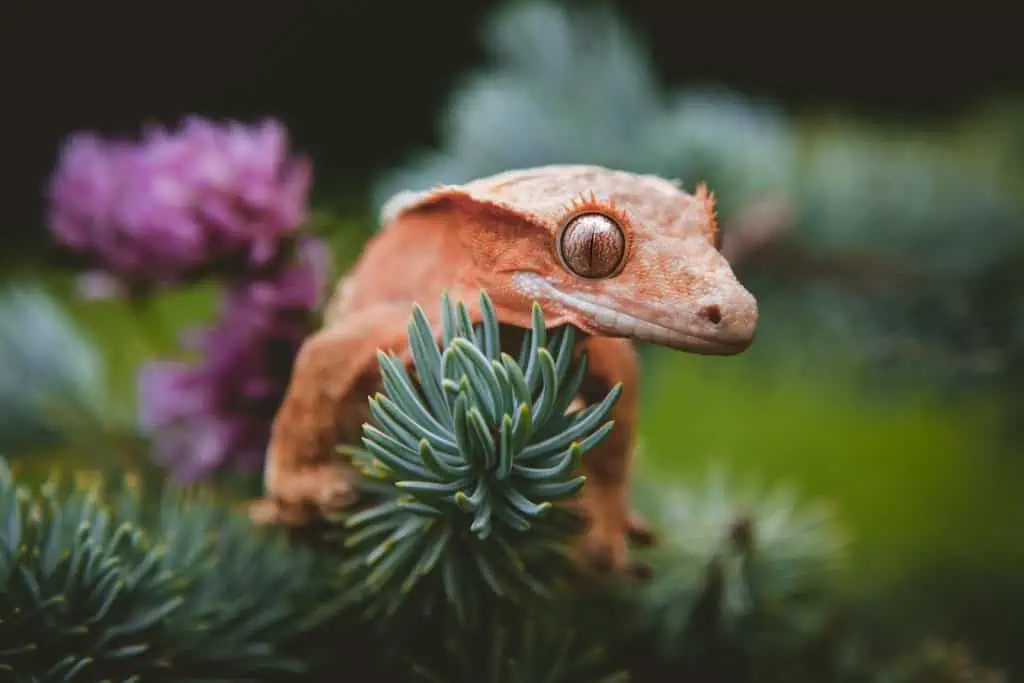Ideal temperature and humidity are the utmost important things when caring for crested geckos to ensure their health & well-being. Even though these little critters are mellow & straightforward to look after – controlling heat & moisture can be tough – especially if you’re a beginner reptile keeper.
Adapted to live in the tropical forests of New Caledonia – cresties are used to warm and humid climates.
A proper warm, humid climate will help stimulate their natural behaviors, such as:
- Exploring
- Eating
- Interacting with their owners.
The wrong temperature or humidity levels can cause adverse health effects, such as:
- Respiratory infections
- Dehydration
- Digestion problem
- Metabolic-bone disease
Maintaining the proper temperature & humidity for your lizard pet can be a challenge, but it’s worth it!
What Is the Correct Temperature & Humidity for a Crested Gecko?
Crested geckos are becoming increasingly popular pets due to their unique appearance & easygoing nature. As with any pet – it is important to understand their needs to ensure they remain healthy & happy.
One factor that can heavily influence the health of your gecko buddy is the temperature & humidity within its enclosure.
To provide the best habitat for your pet – it is essential to recognize what temperature & humidity levels are appropriate.
Crested Gecko Temperature Needs
Crested Geckos need a suitable environment to stay healthy & active; their natural habitat is rain forests of New Caledonia – an island about 750 miles east of Australia with subtropical temperatures ranging from 68°F-83°F.
You can recreate this setting by providing your pet lizard with a few sources of heat. As ectotherms – Crested Geckos depend on external sources of warmth to regulate their metabolism & digestion. With these options – they can easily adjust their body temperature when needed.
Keeping the environment in check will help your Crestie in many ways – from activity level to skin health and growth & development. Taking care to create a suitable habitat for your pet lizard will ensure that it’s able to thrive!
Your Crested Pal requires a specific temperature gradient with three key components.
- Basking Area: You should provide your lizard buddy with a basking area (located near the top of the enclosure) – a spot where they can consistently go to raise their body temperature. You need to make sure the temperature ranges between 82°F-85°F – if it goes above that – it can cause serious overheating & even lead to heatstroke – which is fatal.
- Cooling Area: For the cool spot (located at the bottom of the enclosure) in your crestie’s enclosure – temperatures should be around 70-75°F. If the temperature remains at or below 70°F (22°C) consistently – it can result in feeling tired, loss of appetite, and can make your little pal sick.
- Nighttime Temperature: It is normal for nighttime temperatures to decrease – so it is acceptable if the temperature in your Crested Gecko’s enclosure drops to 65°F-72°F during the night. Your buddy gecko’s health won’t be affected if the temperature goes as low as 50°F – but it is not ideal. Too much fluctuation in temperatures can cause the Crested Gecko a lot of stress & change in behavior. So – you should avoid drastic or sudden changes in temperature.
Crested Gecko Humidity Needs
You need to keep your crestie’s environment humid like it would be in its natural habitat. The humidity should ideally remain between 60-80% throughout the day & a bit lower at night.
It might seem counterintuitive – but these reptiles actually require a more moist atmosphere than other species of lizards. If you don’t keep up with the humidity – your lizard could become uncomfortable or even ill.
Crested Geckos need appropriate humidity levels to control the amount of water they lose through their skin. Too much or too little humidity, and you’re in trouble!😮
High humidity can cause respiratory issues for your gecko – while low levels can lead to dehydration.
How To Provide Heat for Your Crested Gecko’s Enclosure?
You’ll need to get a heat lamp for your buddy gecko. Go with either a white or clear low-wattage incandescent/halogen basking bulb – this will emulate the day/night cycle & warm up the enclosure as well.
Just bear in mind that the wattage of the lamp you choose depends on the following:
- The average temperature of your home
- Size & design of the enclosure
- The distance between it & the bulb
As a rule of thumb – start with 25w and go up or down accordingly. You want to steer away from intense heat since these geckos don’t get much direct sun in their natural environment. So – make sure you don’t opt for an extremely powerful lightbulb. Excessive heat won’t do your buddy any good!
If you’re looking for a heat bulb – I’d suggest considering a small 5.5″ dome lamp – like the 25w Zoo Med Repti Basking Spot Lamp. It’s got some great features – like being compatible with dimmers to control the temperature in your gecko’s enclosure perfectly. Plus – it’s easy on the wallet!
So, why not give it a try?😉
How to Regulate Humidity for Crested Gecko?
Maintaining the right level of humidity for your little pal can be a bit tricky. You need to keep an eye on it & intervene when needed. Thankfully – there are lots of ways you can manage this – increasing or decreasing the humidity depending on what’s needed.
- Spray the enclosure – it’s a great way to provide extra drinking water.
- Decorate the tank with absorbent materials – like wood, soil, coconut fiber, and sphagnum moss – this helps retains moisture.
- Place a water bowl on the warm side of the enclosure – this ensures a constant flow of evaporating water.
- Install Fog Generators or Reptile Humidifiers – they’re great for increasing humidity levels and if it gets too high, you can just turn them off!
Lowering humidity levels is also a straightforward process.
- First – make sure that your gecko has enough ventilation by leaving an inch or two of space between the screen & the top of the enclosure. You can also install an additional vent on one side of the tank to allow air to circulate freely.
- Next – consider replacing wet moss or sphagnum with dry substrates like aspen or paper towel, or you’d change substrate regularly.
- Finally – to decrease your pet’s water intake – give fewer mistings until the humidity reaches 50% or 40%. Also – provide a shallow water bowl as a supplement.
How To Measure Your Crestie’s Enclosure Temperature & Humidity?
To keep track of the humidity & temperature levels in the enclosure – it’s crucial to use hygrometers & thermometers. These devices come in numerous types – but reptile owners often prefer digital ones for their convenience.
I recommend the Repti Zoo 2-Pack Reptile Terrarium Thermometer Hygrometers: they’re inexpensive, come in a two-pack and have a sleek digital display that’s easy to read from afar. For best results – install one at the higher end of the enclosure and one at the lower end.
Moreover – you can get peace of mind by using a temperature gun like the Etekcity Lasergrip 774 – it gives you instant readings on temps anywhere in the terrarium.
So – get these devices to monitor your enclosure and provide just the right temperature gradient for your reptile!
So don’t take chances with your scaly pal – invest in an accurate thermometer to make sure your gecko gets the care it deserves.
How Humid Is Too Humid for a Crested Gecko?
Humidity levels beyond 80% are too high & can cause a variety of health issues. When the air becomes too humid – it can make your gecko feel uncomfortable, increase the risk of skin-related issues such as bacterial or fungal infections & also encourage mold and mildew growth. This can make your gecko sick.
Are Crested Geckos Good With UVB Lighting?
You don’t need UVB lighting for your scaly buddy – but a little bit of it is beneficial. I suggest using a bulb with 3% to 5% output at most.
Unlike other pet reptiles – these nocturnal cuties don’t get much sunlight in the wild – so they don’t need too much sunshine in captivity either.
However – a tiny bit of UVB is good for their health & it gives them some sense of what they’d get in the wild.
If you choose to use a UVB bulb in your gecko’s enclosure, choose one with a low output. You should choose a UVB bulb with 5% (or 5.0) output for your gecko’s enclosure – something like the Lucky Herp Fluorescent Tropical Terrarium Lamp or Zoo Med ReptiSun UVB Lamp.
Not only will it provide your pet reptile with essential health benefits – but its rays can help any live plants you have in there too! You won’t need any higher output than that–it’s more than enough for your crested gecko.
Can Crested Geckos Receive an Excessive Amount of UVB?
You need to be careful when it comes to the UVB exposure of your crested gecko. Too much can cause damage to their eyesight since they are nocturnal animals and cannot shield themselves from the sun. Keep it to a minimum – 5% or lower – for your pet’s health and safety.
Having evolved to a nighttime lifestyle, crested geckos don’t do well in too much UVB light – they naturally live among the trees’ cover with little sunlight exposure.
So, avoid keeping the UVB lights on during the night to replicate their natural day and night cycle. Otherwise, you’ll be disrupting the equilibrium of your gecko’s life!
Are Heat Rocks/Pads Good for Crested Geckos?
Heat rocks and heat pads are big no-nos when it comes to crested geckos! You see – these lizards don’t need extreme temperatures – in fact, concentrated heat sources like these can easily burn their delicate skin.
On top of that – they’re usually not adjustable either; so you never really know what temperature you’re dealing with.
Take Care!
A crested gecko’s temperature & humidity needs are not as complicated as some may think.
With the right research & preparation – you can easily provide ample comfort for your scaly pet. Remember – when it comes to temperature & humidity levels – don’t forget: too much of a good thing can be bad.
Your lizard pet’s health depends on you making sure their habitat is comfortable & safe!
Do you have any further questions about crested gecko temperature and humidity? Let us know in the comments!




